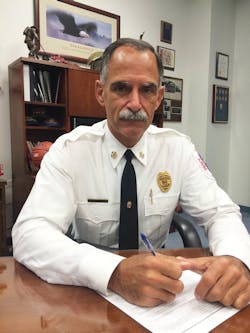Much has been opined on pages like these by many educated, not-so-educated, popular, not-so-popular and, yes, opinionated authors about the criticality of teamwork and crew integrity. Yes, I am one of those authors—my category for which I shall leave to your categorization—but today I want to take a few moments to address the power of ONE individual.
I acknowledge up front that, as I have said many times, organizations shouldn’t fail with the loss of ONE person. It is critical to recognize, however, that the cumulative effects of the addition or subtraction of specific people to our workforce can have significant impacts on our personal well-being and our mission outcomes. Before my union and/or volunteer friends get themselves into a tizzy, this article is by NO MEANS an attack on any level of pay status nor any particular institution or jurisdiction. Just give me a few moments of your time.
Survive and fail, together
On average, ONE person dies in a fire every 3 hours in the United States and ONE firefighter or paramedic dies in the line of duty every 4 days. Similarly, ONE person is murdered every 32 minutes in the United States, and a police officer dies in the line of duty once every 3 days. Firefighters, EMTs, paramedics, police officers, dispatchers—our lives and our missions are inextricably linked, regardless of our color, creed, origins or pay status. We fall and we survive together; however, it is by the power of ONE individual at a time that WE as a team, a collective, will make it home and will make a difference in people’s lives.
Let’s review a simple metaphor to demonstrate how critical the power of ONE can be. Water at 211 degrees F is just hot water. Although 211 individual degrees of heat have come together, all that those degrees are able to do is make hot water. Adding just ONE more degree changes everything. At 212 degrees, the physical state of the water changes and the resulting production of steam creates energy that allows the dormant water to now do new things. The steam created can extinguish fires and can power machines and move turbines that the water itself, in its static state, was not capable of. Clearly, you need to maintain the supply of liquid and the temperature of at least 212 degrees to maintain the capacity to create steam. If ANY of the degrees decides to leave the pack, what happens? You are no longer producing steam, your capacity to create energy in and of itself is reduced, and your vessel will overflow if the supply of liquid is not controlled.
Let’s also remember that there is NO 9-1-2; there is no backup fire department, no backup police department. We’re it, and the people depend on us as much as we depend on each other. It is imperative that we continue to develop our individual and group skills and abilities, while recruiting more folks to add to our physical numbers. As I said above, we survive, and we FAIL, together.
So how does this directly apply to you? Easy. Each of us hold the power of ONE in our hands, whether it be in our individual knowledge, skills and abilities, or in our collective abilities to affect the team/crew. ONE person with the power of individual leadership decisions that will impact the greater outcome. ONE person with the power of responsibility to do the right thing, at the right time, for the right reasons. ONE person with the power of performance to get the job done, individually AND as part of a crew. ONE person responsible to see and set the vision for future success within your organization.
While no one can accurately predict the future (just talk to my weather friends), I do believe that the best way to predict the future is to create it. The power to create that future lies within each ONE of the people who walks in our doors and dons a uniform. Among many other individual and group tasks, it is our responsibility to groom the next leaders of our service, ONE person at a time.
We have drilled team and crew continuity into our folks’ heads, and most people “get it.” What I believe we as organizations have started to lose track of is how important each INDIVIDUAL is to the crew. In recent years, I have begun to see individuals who have forgotten how to do anything themselves. We have to recognize that taking away individual contributions changes the effect on the team/crew, changes the related effects of the emergency they’re involved in, and undoubtedly will change the mission outcome and production of the team.
Recent grant-funded studies that the Prince George’s County Fire and EMS Department (PGFD) participated in while I was chief helped prove the effectiveness of the power of ONE. As chronicled through the scientific analysis conducted in these surveys, the exponential benefits of the power of ONE additional firefighter are undeniable. I encourage you to review the details of the firefighter safety and resource deployment data developed with the help of this project at firereporting.org. (Note: The AFG grant-funded Firefighter Safety and Deployment of Resources Project Team includes the Metro Chiefs, IAFC, IAFF, NIST, Urban Institute and Worchester Polytechnic.)
Yes, chiefs are responsible for scene command and control; however, chiefs should also be setting the vision for the area of responsibility. If you are THE chief, you should be setting the vision for your department. If you are a lower-level chief or individual station chief within a larger combination department, you still have a responsibility to set the vision for your individual sphere, but you also have the responsibility to implement the larger vision.
We have all likely participated in large strategic planning sessions that collectively develop some vision for the future; I call this group vision. I will not impugn the value of strategic planning or directly discount group vision, but it is worth noting that in my 35 years, I have seen more large strategic plans sit on the shelf than I have seen implemented in totality. From time to time, it is absolutely critical to take time to evaluate your mission, your vision, and your direction and outcomes. When those things don’t align, strategic planning is valuable.
In the PGFD, we undertook a strategic reset of sorts in 2011. At that “event,” all elements of the department were brought together “off-campus” to talk about specific issues, including evaluating the mission and vision. After that exercise and evaluation with our deputies, I (as chief) determined that we would take on individual issues—what I ended up calling “mini-strategic-plans”—ONE issue at a time.
The success of these implementations supports another angle of the power of ONE concept in that ONE piece at a time, implementation was successful, where previous broad scope plans had been unsuccessful. This goes back to the ONE vision being set by the chief, then “sold” to the political establishment and budgetary folks by that ONE chief. No group attack, no bloated presentations, just simple, realistic and factually supported data with results-driven outcome-predictions that made the previously unbelievable or unattainable, believable and attainable.
To date over the 5-year span, those individual (ONE) strategic plans have netted a 30 percent budget increase, an $18 million apparatus investment, a $12 million equipment investment (SCBA), a 25 percent increase in hiring and a 50 percent increase in volunteer-force investments. Make no bones about it, these are NOT ad hoc thoughts, ideas or ramblings; these are pieces of the pie that ONE person visualized as attainable based on the data supplied by other “ONEs.” This was essentially an exercise in collaboration, allowing everyone the opportunity for input, but allowing those who shared the ONE vision the opportunity to flesh out their ideas more.
Too many times, we see people get into positions where they stifle ideas and progress in the interest of some errant vision of their own. They can’t see the forest for the trees, as the saying goes. They may be infatuated with being “THE chief,” which to them means you do everything THEIR way, and anything else is an attack on their POWER. This can be a negative power of ONE, without proper introspective analysis or proper oversight from officials with oversight responsibility.
In a recent Chief Concerns column titled “Be a Leader Who People NEED”, I talked about the 10/80/10 principles where 80 percent of your people are actually getting things done and the others are either leading or derailing the organization. A reader wrote to me, asking how the organization could move forward when the 80 percent who wanted to move forward were looked down on because they want what’s best for the community and not necessarily the organization. He talked about how difficult it was with “a sense of defeated morale because guys are not allowed or encouraged to exceed.” I gave him some advice about developing a mini-strategic look at the agency and focusing on what’s “right” with like-minded individuals.
This sense of “morale defeat” could be the ramblings of an errant member or it could be a perfect example of how the power of ONE vision at a time (in this case, the chief’s sole vision) can have a negative ripple effect on an organization. These chiefs need to take a few moments to evaluate both their leadership style and the current state of their department. It may not be as rosy as they believe!
In sum
Volunteer or paid—it doesn’t matter. Grandma Jones DOESN’T CARE! Like I said before, there is NO 9-1-2 and NO backup fire department. You’re it. We’re it. You have the power of ONE in your responsibility of performance and leadership. Whether you’re the chief or a line firefighter, Grandma Jones looks to YOU in her time of need, during her darkest moments. The power to positively influence others lies within each of us.
About the Author

Marc S. Bashoor
MARC S. BASHOOR joined the fire service in 1981. In 2017, he retired as fire chief of Prince George’s County, MD, Fire/EMS, the largest combination department in North America. His progressive community-based approach led to record hiring and a strategic apparatus replacement plan.
Twitter: @ChiefBashoor
Email: [email protected]
